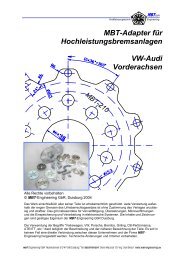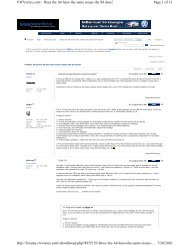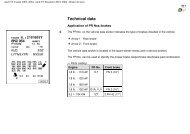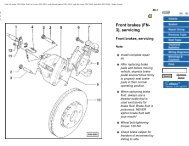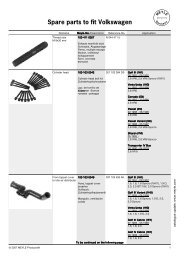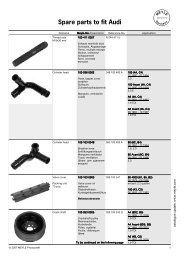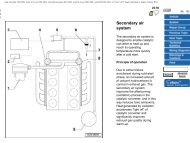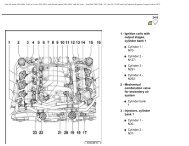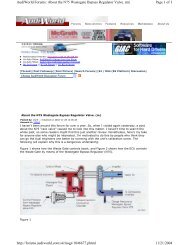VW MKII A2 MK2 Golf Jetta Fox Service Manual - VAGLinks.com
VW MKII A2 MK2 Golf Jetta Fox Service Manual - VAGLinks.com
VW MKII A2 MK2 Golf Jetta Fox Service Manual - VAGLinks.com
You also want an ePaper? Increase the reach of your titles
YUMPU automatically turns print PDFs into web optimized ePapers that Google loves.
Repair of rust holes or gashes in<br />
bodywork<br />
Remove all paint from the affected area and<br />
from an inch or so of the surrounding sound<br />
bodywork, using an abrasive pad or a wire<br />
brush on a power drill. If these are not<br />
available a few sheets of abrasive paper will<br />
do the job most effectively. With the paint<br />
removed you will be able to judge the severity<br />
of the corrosion and therefore decide whether<br />
to renew the whole panel (if this is possible) or<br />
to repair the affected area. New body panels<br />
are not as expensive as most people think<br />
and it is often quicker and more satisfactory<br />
to fit a new panel than to attempt to repair<br />
large areas of corrosion.<br />
Remove all fittings from the affected area<br />
except those which will act as a guide to the<br />
original shape of the damaged bodywork (eg<br />
headlamp shells etc). Then, using tin snips or<br />
a hacksaw blade, remove all loose metal and<br />
any other metal badly affected by corrosion.<br />
Hammer the edges of the hole inwards in<br />
order to create a slight depression for the filler<br />
paste.<br />
Wire brush the affected area to remove the<br />
powdery rust from the surface of the<br />
remaining metal. Paint the affected area with<br />
rust inhibiting paint, if the back of the rusted<br />
area is accessible treat this also.<br />
Before filling can take place it will be<br />
necessary to block the hole in some way. This<br />
can be achieved by the use of aluminium or<br />
plastic mesh, or aluminium tape.<br />
Aluminium or plastic mesh or glass-fibre<br />
matting, is probably the best material to use for<br />
a large hole. Cut a piece to the approximate<br />
size and shape of the hole to be filled, then<br />
position it in the hole so that its edges are<br />
below the level of the surrounding bodywork. It<br />
can be retained in position by several blobs of<br />
filler paste around its periphery.<br />
Aluminium tape should be used for small or<br />
very narrow holes. Pull a piece off the roll and<br />
trim it to the approximate size and shape<br />
required, then pull off the backing paper (if<br />
used) and stick the tape over the hole; it can<br />
be overlapped if the thickness of one piece is<br />
insufficient. Burnish down the edges of the<br />
tape with the handle of a screwdriver or<br />
similar, to ensure that the tape is securely<br />
attached to the metal underneath.<br />
Bodywork repairs - filling and<br />
respraying<br />
Before using this Section, see the Sections<br />
on dent, deep scratch, rust holes and gash<br />
repairs.<br />
Many types of bodyfiller are available, but<br />
generally speaking those proprietary kits are<br />
best for this type of repair which contain a tin<br />
of filler paste and a tube of resin hardener, or<br />
a ‘no mix’ which can be used directly from the<br />
tube. A wide, flexible plastic or nylon<br />
applicator will be found invaluable for<br />
imparting a smooth and well contoured finish<br />
to the surface of the filler.<br />
Mix up a little filler on a clean piece of card<br />
or board - measure the hardener carefully<br />
(follow the maker’s instructions on the pack)<br />
otherwise the filler will set too rapidly or too<br />
slowly. Alternatively, a ‘no mix ‘can be used<br />
straight from the tube without mixing, but<br />
daylight is required to cure it. Using the<br />
applicator apply the filler paste to the<br />
prepared area; draw the applicator across the<br />
surface of the filler to achieve the correct<br />
contour and to level the surface. As soon as a<br />
contour that approximates to the correct one<br />
is achieved, stop working the paste - if you<br />
carry on too long the paste will be<strong>com</strong>e sticky<br />
and begin to pick-up on the applicator.<br />
Continue to add thin layers of filler paste at<br />
twenty minute intervals until the level of the<br />
filler is just proud of the surrounding<br />
bodywork.<br />
Once the filler has hardened, excess can be<br />
removed using a metal plane or file. From then<br />
on, progressively finer grades of abrasive<br />
paper should be used, starting with a 40<br />
grade production paper and finishing with a<br />
400 grade wet-and-dry paper. Always wrap<br />
the abrasive paper around a flat rubber, cork,<br />
or wooden block - otherwise the surface of<br />
the filler will not be <strong>com</strong>pletely flat. During the<br />
smoothing of the filler surface the wet-and-dry<br />
paper should be periodically rinsed in water.<br />
This will ensure that a very smooth finish is<br />
imparted to the filler at the final stage.<br />
At this stage, the dent should be<br />
surrounded by a ring of bare metal, which in<br />
turn should be encircled by the finely<br />
feathered edge of the good paintwork. Rinse<br />
the repair area with clean water, until all of the<br />
dust produced by the rubbing-down<br />
operation has gone.<br />
Spray the whole area with a light coat of<br />
primer, - this will show up any imperfections in<br />
the surface of the filler. Repair these<br />
imperfections with fresh filler paste or<br />
bodystopper and once more smooth the<br />
surface with abrasive paper. If bodystopper is<br />
used, it can be mixed with cellulose thinners<br />
to form a really thin paste which is ideal for<br />
filling small holes. Repeat this spray and<br />
repair procedure until you are satisfied that<br />
the surface of the filler and the feathered edge<br />
of the paintwork are perfect. Clean the repair<br />
area with clean water and allow to dry fully.<br />
The repair area is now ready for final<br />
spraying. Paint spraying must be carried out<br />
in a warm, dry, windless and dust free<br />
atmosphere. This condition can be created<br />
artificially if you have access to a large indoor<br />
working area, but if you are forced to work in<br />
the open, you will have to pick your day very<br />
carefully. If you are working indoors, dousing<br />
the floor in the work area with water will help<br />
to settle the dust which would otherwise be in<br />
the atmosphere. If the repair area is confined<br />
to one body panel, mask off the surrounding<br />
panels; this will help to minimise the effects of<br />
a slight mis-match in paint colours. Bodywork<br />
fittings (eg chrome strips, door handles etc)<br />
will also need to be masked off. Use genuine<br />
1081 <strong>VW</strong> <strong>Golf</strong> & <strong>Jetta</strong><br />
Bodywork and fittings 11•3<br />
masking tape and several thicknesses of<br />
newspaper for the masking operations.<br />
Before <strong>com</strong>mencing to spray, agitate the<br />
aerosol can thoroughly, then spray a test area<br />
(an old tin, or similar) until the technique is<br />
mastered. Cover the repair area with a thick<br />
coat of primer; the thickness should be built<br />
up using several thin layers of paint rather<br />
than one thick one. Using 400 grade wet-anddry<br />
paper, rub down the surface of the primer<br />
until it is really smooth. While doing this, the<br />
work area should be thoroughly doused with<br />
water and the wet-and-dry paper periodically<br />
rinsed in water. Allow to dry before spraying<br />
on more paint.<br />
Spray on the top coat, again building up the<br />
thickness by using several thin layers of paint.<br />
Start spraying in the centre of the repair area<br />
and then, with a side-to-side motion, work<br />
outwards until the whole repair area and<br />
about 50 mm of the surrounding original<br />
paintwork is covered. Remove all masking<br />
material 10 to 15 minutes after spraying on<br />
the final coat of paint.<br />
Allow the new paint at least two weeks to<br />
harden, then, using a paintwork renovator, or<br />
a very fine cutting paste, blend the edges of<br />
the paint into the existing paintwork. Finally,<br />
apply wax polish.<br />
Plastic <strong>com</strong>ponents<br />
With the use of more and more plastic body<br />
<strong>com</strong>ponents by the vehicle manufacturers (eg<br />
bumpers, spoilers and in some cases major<br />
body panels), rectification of more serious<br />
damage to such items has be<strong>com</strong>e a matter<br />
of either entrusting repair work to a specialist<br />
in this field, or renewing <strong>com</strong>plete<br />
<strong>com</strong>ponents. Repair of such damage by the<br />
DIY owner is not really feasible owing to the<br />
cost of the equipment and materials required<br />
for effecting such repairs. The basic technique<br />
involves making a groove along the line of the<br />
crack in the plastic using a rotary burr in a<br />
power drill. The damaged part is then welded<br />
back together by using a hot air gun to heat<br />
up and fuse a plastic filler rod into the groove.<br />
Any excess plastic is then removed and the<br />
area rubbed down to a smooth finish. It is<br />
important that a filler rod of the correct plastic<br />
is used, as body <strong>com</strong>ponents can be made of<br />
a variety of different types (eg polycarbonate,<br />
ABS, polypropylene).<br />
Damage of a less serious nature (abrasions,<br />
minor cracks etc) can be repaired by the DIY<br />
owner using a two-part epoxy filler repair<br />
material or a ‘no mix’ which can be used<br />
directly from the tube. Once mixed in equal<br />
proportions (or applied direct from the tube in<br />
the case of a ‘no mix’), this is used in similar<br />
fashion to the bodywork filler used on metal<br />
panels. The filler is usually cured in twenty to<br />
thirty minutes, ready for sanding and painting.<br />
If the owner is renewing a <strong>com</strong>plete<br />
<strong>com</strong>ponent himself, or if he has repaired it<br />
with epoxy filler, he will be left with the<br />
problem of finding a suitable paint for finishing<br />
which is <strong>com</strong>patible with the type of plastic<br />
11



